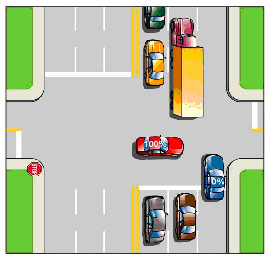Leaving stop sign, hit vehicle in through street
作者:
最后更新于 | 最初发布于 | 分类: 开车用车

离开停车的标志时,碰上直行道上的车。
Crash example: A vehicle stops at a stop sign. When it proceeds onto the through street, it is hit by traffic on the through street.
The courts will generally rule that the vehicle leaving the stop sign is 100 per cent at fault. It should not leave the stop sign if the traffic on the through street is approaching so closely that it is an immediate hazard.
However, if the vehicle has left the stop sign in a lawful manner, any through traffic must then yield to it. Responsibility depends on whether the driver leaving the stop sign made a sufficient and substantial prior entry into the intersection and whether there was sufficient opportunity for either driver to avoid the collision. (Motor Vehicle Act, Section 175)
中文翻译:
碰撞例子:一辆车在停车标志前停下,当它准备通过路口时, 撞到了横向通行的车辆。
法庭通常会判决,离开停车标志的那辆车100%责任。它不应当离开停车标志,因为路口横向的车辆太靠近了,显然是个当即的危险。
然而,如果它是合法的离开停车标志,其他的横向车辆就应当让路给它。责任的区分依赖于离开停车标志的车辆,是否有明显足够的优先进入路口以及所有的司机是否有足够的机会来避免碰撞。
(Motor Vehicle Act, Section 175)
Gautreau v. Hollige
2000年,BC法庭有一个上诉案,Gautreau v. Hollige (2000) BCCA 390,发生在温哥华的Drake街和Burrard街路口。
一个司机在Drake街向西行,在路口停车标志处停下,然后进入Burrard街,试图穿过北行的车道,然后转南。另一个司机在Burrard街向北行,就撞上了。
法庭判定,在快车道上的司机没有采取必要的躲避措施,如踩刹车等。另一个司机负有更多的责任,他是在不安全的情况下进入路口。所以,离开停车标志进入路口的司机承担75%责任,快车道上的司机承担25%责任。
Fenster v. Yuen
B.C.省法庭有一个案例,Fenster v. Yuen [2003] BCPC 33,一个司机准备穿过一个四车道的高速路。他在Manitoba街口的停车标志处停下,准备穿过西二街,路边车道的司机在西二街停下,所以他就想在他们之前通行。从东边过来的两个车道上的车辆非常快。等着车辆过去,然后再通行的车子被西边过来的车子撞到。
法官说,穿行通过高速路的车辆必须十分小心,撞到他的车辆有证据看到紧急刹车,证明对于她来说是突然的危险状况。 那个穿行的司机有责任避让她。没有证据说明那个女司机疏忽了。那个穿行的司机承担100%责任。
Twining v. Huang
In the British Columbia Supreme Court case of Twining v. Huang [1999] WL 33193367, an accident occurred at the intersection of 64th Avenue and Angus Drive in Vancouver. One of the drivers was travelling north on Angus Drive, which had a stop sign at the intersection. The other driver was approaching from the east on 64th Avenue. The first driver had stopped at the stop sign on Angus Drive. The stopped driver then accelerated through the intersection. The other driver slammed on her brakes, but was unable to avoid the collision.
The judge said that there was no evidence that the through driver had failed to keep an adequate lookout; she was not speeding, and could not have avoided the accident. The stopped driver, the judge said, had a clear duty to look to her right to see if there were any approaching vehicles, which may have been an immediate hazard to her. If she had looked, the judge went on to say, she would have seen that the approaching vehicle was a threat. Therefore, the stopped driver had a duty to yield the right-of-way to the through driver, and was 100 per cent at fault.
Goerzen v. Sjolie
In the British Columbia Supreme Court case of Goerzen v. Sjolie [1995] WL 1743586, a fatal accident occurred in the District of Matsqui, in British Columbia. One of the drivers was in a car with her daughter and her daughter's friend. She approached the intersection and was stopped at the stop sign for her direction of travel. A truck was approaching from the east. It was approximately 50 feet from the intersection when the car left the stop sign and slowly entered the intersection. The truck hit the car, spinning it around and throwing the driver out of the car, killing her. The truck was the dominant driver as it was on a through road. There was not enough evidence to say the truck had been speeding.
The judge said the truck was so close to the intersection that it was an immediate hazard. Therefore, the car should have yielded the right-of-way. The car was 100 per cent at fault.